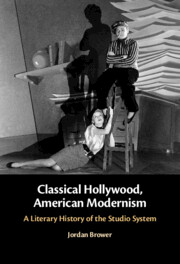Book contents
- Classical Hollywood, American Modernism
- Classical Hollywood, American Modernism
- Copyright page
- Dedication
- Contents
- Figures
- Acknowledgments
- Introduction
- Chapter 1 Paramount Pictures and Transmedial Possibility
- Chapter 2 MGM Modernism
- Chapter 3 The Motion Picture Industry’s Coming of Age
- Chapter 4 Global Hollywood
- Chapter 5 The Scenes of an Ending
- Chapter 6 Conclusion
- Notes
- Index
Chapter 2 - MGM Modernism
Published online by Cambridge University Press: 04 January 2024
- Classical Hollywood, American Modernism
- Classical Hollywood, American Modernism
- Copyright page
- Dedication
- Contents
- Figures
- Acknowledgments
- Introduction
- Chapter 1 Paramount Pictures and Transmedial Possibility
- Chapter 2 MGM Modernism
- Chapter 3 The Motion Picture Industry’s Coming of Age
- Chapter 4 Global Hollywood
- Chapter 5 The Scenes of an Ending
- Chapter 6 Conclusion
- Notes
- Index
Summary
Beginning in the late 1920s, MGM usurped Paramount’s position as the most profitable and prestigious studio, largely as a result of the oversight of wunderkind producer Irving Thalberg. Thalberg helped develop the corporate personality of MGM – the MGM “Idea” – comprising a glamorous and slick house style, the prioritization of stars, and a system of scriptwriting that involved assigning multiple writers to work on the same project yet often unbeknownst to each other. It is in response to this last phenomenon that authors of very disparate sensibilities – F. Scott Fitzgerald (The Love of the Last Tycoon [1941]), Aldous Huxley (After Many a Summer Dies the Swan [1939]), and William Faulkner (Absalom, Absalom! [1936]) – crafted narratives in a form I call “MGM Modernism”: an aestheticized and self-conscious naturalism developed in part from contact with and subordination to a corporate author.
Keywords
- Type
- Chapter
- Information
- Classical Hollywood, American ModernismA Literary History of the Studio System, pp. 54 - 83Publisher: Cambridge University PressPrint publication year: 2024

